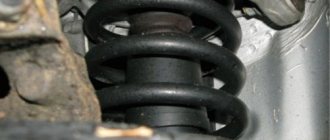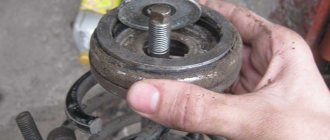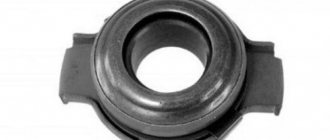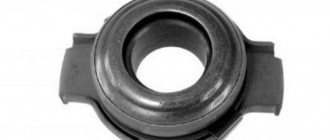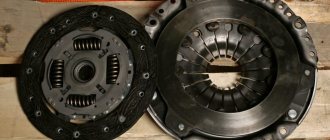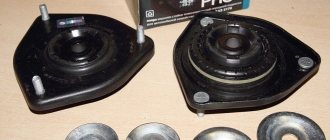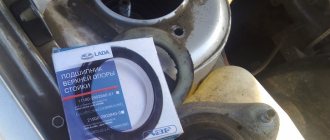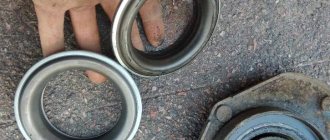1200 rub. for the photo report
We pay for photo reports on car repairs. Earnings from 10,000 rubles/month.
Write:
When malfunctions occur in the front suspension of a car, one of the first measures that its owner should take is to check the support bearing located between the support and the upper spring cup. To do this, you will need to grab the “cup” of the rack with your hand (put your hand on the support) and rock the car. Constant, sharply changing loads, including shock loads in combination with abrasive dust particles, contribute to the wear of the components of the support strut bearing and ultimately completely disable it. As a result, it begins to play, knock, squeak or squeak, and the shock absorber rod deviates from its axis.
Diagram of the support bearing operation
Such problems with its operation can lead to more serious consequences in the car’s suspension. Since wear of the support bearing will lead to a violation of the wheel alignment angles, and consequently, a deterioration in the car’s handling and accelerated tire wear. How to check and which manufacturer of thrust bearings to give preference to when replacing - we will tell you about all this in more detail.
Signs of a faulty support bearing
The main sign of a breakdown, which should alert the driver, is a knocking sound in the area of the front left or right side members . In fact, other suspension parts can also be sources of knocking and squeaking, but you need to start checking with the “support”.
Unpleasant sounds are especially noticeable when driving on uneven roads, over potholes, on sharp turns, and when the car is heavily loaded. That is, in conditions of critical suspension operation. In addition, the driver will probably subjectively feel a decrease in the car’s controllability. The steering does not respond so quickly to its actions; a certain inertia appears. The car also begins to “scour” along the road.
Analysis of typical complaints
The advice given at the beginning, to understand when the tapping occurs, makes it somewhat easier to find the cause. But this recommendation is effective only with a comprehensive diagnosis. For example, the mere fact of clanking in the pits is not enough; you need to listen to what is happening when the wheels are turned and whether there are any sounds in place.
If the test is done, go through common complaints.
- The noise only appears when the steering wheel is turned. If nothing is transmitted to the steering wheel, then see “ball” in more detail. Perhaps it is not tightly attached to the steering knuckle or lever. For example, bolts are often forgotten to be tightened during wheel alignment.
- The knock comes from the steering wheel. This is either a rack or a cardan on the shaft. If this only occurs on washboards and other irregularities, inspect the control shaft telescopic connection. Pay attention to the rack and pinion mechanism - the nuts securing it to the subframe or body may be loose.
- The rattle is only on the straight line, quiet in turns. Rack, cardan, ball joints.
Causes of failure
The main reasons for the failure of support bearings are dust and water penetrating inside, lack of lubrication there, and also, not rarely, due to a strong impact on the rack. Read more about these and other causes of support bearing failure:
- Natural wear of the part . Unfortunately, the quality of domestic roads leaves much to be desired. Therefore, when operating the machine, be prepared for the fact that the bearings will be subject to more wear than their manufacturer claims.
- Sand and dirt getting inside the mechanism . The fact is that a journal bearing is a type of rolling bearing, and it does not structurally provide protection from the mentioned harmful factors.
- Abrupt driving style and failure to comply with speed limits. Driving on bad roads at high speed leads to excessive wear not only on the support bearing, but also on other elements of the vehicle’s suspension.
- Low quality parts or defects . This is especially true for domestically produced bearings, in particular for VAZ cars.
Front support device
Preparing for diagnosis
You need to start by trying to determine the location and nature of the sound. A clear and loud knock in the steering wheel is generated by the impacts of metal on metal, while a muffled knock is generated by metal on plastic. Check the tire pressure: their difference can also cause noise.
Before inspection, you need to clean the front suspension, the easiest way is with a powerful jet of water. After it dries, you can put the car on a pit or viewing platform. There you need to wipe the parts dry with a rag and, if necessary, clean off dried dirt or rust with a brush. Among other things, this way you will save yourself from sand falling from above.
When preparing to diagnose the suspension, you should pay attention to the tightening of the threads, rubber cushions and boots.
How to check a support bearing
Next, we will consider the question of how to determine a faulty support bearing with your own hands based on a characteristic sign. This is quite easy to do. To recognize how support bearings knock, there are three methods for checking the support bearing at home:
- It is necessary to remove the protective caps and press the upper element of the front strut rod with your fingers. After this, rock the car from side to side by the wing (first in the longitudinal and then in the transverse direction). If the bearing is faulty, you will hear a familiar knocking noise that you heard when driving a car on a rough road. In this case, the car body will sway, and the stand will either stand still or move with a smaller amplitude.
- Place your hand on the front shock spring coil and have someone sit behind the wheel and turn the steering wheel from side to side. If the bearing is worn out, you will hear a metallic knock and feel the recoil with your hand.
- You can focus on sound. Drive your car on uneven roads, including speed bumps. When there is a significant load on the suspension system (sharp turns, including at high speed, driving over bumps and holes, sudden braking), a metallic knocking sound of the support bearings will be heard from the front wheel arches. You will also feel that the car's handling has deteriorated.
Checking the “supporters” on VAZs
How do support bearings knock?
To extend the service life of a given bearing, very often, if the design allows it, mechanics wash and change the lubricant. If the part is partially or completely out of order, the support bearing is not repaired, but replaced. In this regard, a logical question arises - which support bearings are best to purchase and install?
Ford Mondeo support bearing repair
Detailed photo instructions on how to independently restore the performance of a Ford Mondeo support bearing. Do-it-yourself repair of the support bearing of the Ford Mondeo shock absorber strut Read more
Shock absorber (car shock absorbers)
The shock absorber ensures safety and comfort when driving by absorbing shocks, jolts, and vibrations of moving suspension elements. Therefore, it is important to promptly eliminate shock absorber problems—properly maintain them and replace them in a timely manner. More details
Checking car shock absorbers
This video shows the consequences of faulty shock absorbers, and also describes popular testing methods: swaying, behavior on the road, what to look for during visual diagnostics Read more
Knocks when turning the steering wheel while driving
When a wheel hits a sharp bump, the joint, which has lost its rigidity, produces a characteristic knock due to the gap. The problem is resolved by searching for the faulty part, replacing it or repairing it. Knocks when turning the steering wheel while driving on uneven surfaces may indicate probable wear of the following components and elements:
- steering rack mechanism
- steering rods
- steering tips
- rack housing fastenings
- ball joints
- shock absorbers
- anti-roll bar bushings
To restore the power steering rack, special repair kits are provided, which include a set of seals, oil seals and bushings. A high-quality overhaul and correctly adjusted unit will return it to almost its original condition, at an adequate cost for labor and spare parts. Due to the complexity of their design, many electrically driven racks cannot be disassembled or repaired. If an internal fault is diagnosed, this expensive unit is replaced only as an assembly.
A knocking noise when turning the steering wheel left or right on the road can be caused by a worn-out shock absorber. The shock absorption efficiency of a worn or leaking suspension damping element is significantly lower than normal, and when receiving load as a result of body roll in turns, on bumps and potholes, such a shock absorber “breaks through.” If MacPherson struts are installed on the front suspension, the bearing of the support cup may also produce a knock when cornering.
The cause of a knocking sound when turning the steering wheel in motion can be wear of the rubber clamps and bushings through which the rack body is attracted to the body or subframe. At the same time, the rack is not rigidly fixed, but “dangles” in its fastenings and knocks when the steering wheel is turned to the right or left, as well as when driving over bumps and holes. The same applies to worn-out SPU bushings, which are not able to tightly hold the stabilizer rod, causing it to move, vibrate and knock due to increased free play.
How to choose support bearings
So, today on the auto parts market you can find “supports” from different manufacturers. It is best, of course, to buy original spare parts that are recommended by the manufacturer of your car. However, most car owners, as an alternative, buy non-original bearings in order to save money. And here a kind of lottery arises. Some manufacturers (mainly from China) produce quite decent products that can, if not compete with original spare parts, then at least come close to them. But there is a danger of buying an open marriage. Moreover, the likelihood of purchasing a low-quality bearing is much higher. We present to you information about popular brands of journal bearings, reviews of which we were able to find on the Internet - SNR, SKF, FAG, INA, Koyo. When purchasing branded products, always pay attention to the presence of branded packaging . It is, in fact, an analogue of a passport for a bearing, which is usually issued by domestic manufacturers.
Getting to know the journal bearing
To begin with, I suggest the simplest thing - getting to know the device. The support bearing (OS) is necessary to create a movable connection between the machine body and the shock absorber. On VAZ 2110, 2114 cars, models such as Grant, Kalina, Priora, as well as on all kinds of foreign cars Mitsubishi, Volkswagen, Fiat or Toyota, for example, the location of the OP is approximately the same - the upper part of the pillar. Install the bearing between the support and the upper cup (or cup, anyone) of the shock absorber spring.
If we look at it purely from a design point of view, then we have a variation of rolling bearings. But OP differs from them in the large thickness of the outer ring. The rolling bodies are cylindrical rollers. They are placed perpendicularly and separated from each other. Due to this design, the unit can take on loads from different sides.
The task of the OP is to provide the shock absorbers with the ability to rotate freely in the supports. In any car, be it a Ford Focus or Mondeo, Chevrolet Lanos, Cruze, Lacetti, Aveo, Daewoo Nexia, Hyundai Accent or Skoda Octavia, the OP will always be slightly higher than the front spring. The shock absorber rod will pass through the central cavity of the element. Shock absorber bodies are always mounted to the body where the OP is located. As a result, two types of loads act on the support - axial and radial.
Before you replace and buy a new element to replace the old OP, you need to understand their types. This is where we will start. Do you agree? Then go ahead.
Types of OP
It’s difficult to say for sure which OP is better to buy. Much depends on the specific car. How to check if OP is good or not? First, ask how much the bearings cost. Good parts cannot be cheap. But it’s not worth chasing the most expensive models if you have a budget car. Try to choose the golden mean.
Besides the fact that you need to look at the manufacturer, the specific type of bearing will be an important consideration. There are several varieties of this device.
- OP having a built-in inner or outer ring. For installation, mounting holes on the housing are used, so there is no need for clamping flanges.
- OP, in which the inner ring is separated. Structurally, the outer ring is connected to the body. It is important to take such devices in cases where you need to achieve the most accurate rotation of the outer ring.
- OP having a detachable outer ring. This is the opposite version of the previous bearing. Accordingly, they are taken if necessary to obtain precise rotation of the internal element.
- Single split bearings. The outer ring on such OPs is divided into one precisely. With their help, high rigidity values are achieved.
Sooner or later the fault will manifest itself. This mainly occurs due to dirt, sand and moisture getting into the unit. On average, the first signs of a malfunction appear after about 50-75 thousand kilometers. Replacement is recommended every 100 thousand kilometers.
Can the newest springs knock?
The new springs knock occasionally. But, with the decline in the price sector of spare parts, a similar phenomenon is observed more and more often. The occurrence of knocking in new racks is usually associated with 2 reasons:
- factory defect;
- unqualified installation.
Installation errors or defects unnoticed during installation in more than half of the cases are the cause of third-party sounds in the suspension.
IMPORTANT! If a knocking noise occurs after replacing the shock absorbers, you should not wait until it goes away on its own. Most likely, the problem will not go away over time. But the possibility that mating parts will be damaged due to play in the chassis will increase.
What indicates a malfunction
It is not always necessary to undergo complex diagnostics and a visit to a service station to understand that the support bearing has come to an end.
In fact, there are two main indicators of a breakdown or, at least, an unsatisfactory condition of the device, which requires mandatory replacement in the near future.
Many cars experience a knocking noise. But this is not true for all cars, since knocking in the struts may be absent due to design features. Therefore, motorists more often pay attention to changes in steering behavior. It is more difficult to steer a car; you constantly need to steer if you are driving in a straight line. Moreover, when it leads in one direction or another, you can understand what kind of persistent problem it is.
Causes of failure
Everything about the signs is very clear. But you need to know why such a malfunction occurs, and try to prevent premature wear of the support bearing on the front struts in the future.
- Natural destructive processes. Each OP has its own resource, which is usually developed after 80-100 thousand kilometers. Sometimes, if operating conditions are difficult, wear occurs faster. Therefore, it is better to check the condition of the OP every 20 thousand km.
- Aggressive driving. If you like to race, corner sharply and literally rape your car, which I categorically do not approve of, then your OP will not last anywhere near 100 thousand km. Such piloting speeds up the wear process significantly.
.
- Questionable bearing quality. Many car owners try to save money by buying cheap parts. But they serve little purpose and can fail at the most inopportune moment. Therefore, dear car owners, do not skimp on such important things.
Knock in the steering wheel on uneven surfaces when driving straight ahead
In cases where knocking is heard on the steering wheel when driving over uneven surfaces, this may indicate wear on the bearings of the steering column shaft located in the cabin. This malfunction causes radial play of the shaft, accompanied by knocking. Axial play of the shaft is also possible due to wear of the locking or sealing rings. In some cases, manufacturers provide the supply of spare parts for inexpensive repair of the dispenser. During the overhaul, related parts, fastening and sealing elements are also replaced, which may still be in working order, but may soon fail and require repeated repair of the unit. On a number of models where disassembly and restoration are not provided, the steering column is replaced as an assembly.
Replacement procedure
If you look at the photo, then structurally all OPs look approximately the same. The layout of the front struts on different cars also has minor differences.
But this does not give reason to use, for example, a Zhiguli repair manual in the process of replacing a support bearing on a Renault Logan, Nissan Almera, Hyundai Accent or Mitsubishi Outlander car. I recommend arming yourself with the instruction manual that came with your machine. Even if you bought a used car, and the previous owner did not give you the manual, it will not be difficult to find it online or buy it in stores.
It is this manual for a specific car with a specific engine that is the best guide for self-repair and maintenance. So that you understand what is involved in the process of replacing a support bearing, I suggest that you familiarize yourself with the approximate process.
I tried to highlight the main points that each of you needs to know.
- If the bearing is completely or partially broken, then there is no point in trying to repair it. There are no elements that could be restored. So feel free to buy a new bearing right away. Its price can be from a couple of hundred rubles.
- Loosen the tension on the nuts that secure the support. On most cars it is located in the engine compartment. There are 3 of them.
- Raise the part of the car with a jack where repairs are planned. Remove the wheel.
What conclusions can be drawn? OP, that is, the support bearing, is a relatively small suspension element. At the same time, it plays a huge role in the quality of its operation and the safety of driving. Therefore, it is important to monitor its condition and replace it on time.
Write in the comments what you think about this. Be sure to subscribe and invite your friends and acquaintances. Together, as they say, it's more fun.
(
1 ratings, average: 5.00 out of 5)
Did you like the article?
Subscribe to updates and receive articles by email!
We guarantee: no spam, only new articles once a week!
In this article we will get acquainted with a small but very important component of a car's suspension - this is the front strut support bearing (in common parlance, a support bearing).
Let's try to find out why it is needed, what threatens it, and how to determine that a part requires replacement.
There is not a single unnecessary part in the machine, so if at least one of them fails, this can pose a threat to its overall performance. As a rule, a harbinger of malfunctions can be:
- changes in vehicle behavior;
- the appearance of extraneous sounds and knocks;
- unusual vibrations.
There is a common point of view - a good knock will always appear, although the fruits of such a result often turn into expensive repairs or more tragic consequences.
Boot rupture and mechanism wear
The rubber boot on the crankcase serves to protect the entire steering mechanism from dirt, dust and moisture. In addition, it prevents lubricant from leaking out of the crankcase. You've probably heard the phrase “steering rack is leaking.” So, this lubricant leaks out through the torn boot. Damage to it will inevitably lead to premature failure of the control mechanism. In addition to leaving it without lubrication, moisture and dust will seriously accelerate the wear process. If you discover that the steering rack is leaking in your car, immediately go to the store for a new boot. And don't forget to buy lubricant.
The cause of knocks from below can be faults not only in the suspension, but also in the steering of the car.
The condition of the steering greatly affects both the ease of driving and traffic safety.
The cause of knocks and vibrations on the steering wheel can be the condition of the ball joints of the steering rods and steering mechanism, and the condition of the car's wheels.
To check the steering, place the car on a horizontal platform, open the hood and perform the following operations.
1. Turn the wheels to the right until they stop. In this position, the left wheel tie rod ball joint becomes accessible, which can be seen from under the left wing of the car.
2. Check the integrity of the rubber protective boot of the steering rod joint.
3. Have an assistant rock the steering wheel from side to side and observe the connection between the ball joint and the telescopic strut arm.
There should be no visible play (play) in the ball joint.
Be sure to replace a tie rod end with a damaged joint boot or increased play in the joint with a new one.
When replacing tie rod ends, wheel alignment angles may be disrupted.
4. Check the condition of the right wheel joint in the same way.
5. A rack and pinion steering mechanism is installed on the front panel separating the engine compartment from the passenger compartment.
Ask an assistant to sharply shake the steering wheel left and right and watch the steering mechanism.
If the steering gear housing moves from side to side, it is necessary to tighten its mounting to the body.
Do not use excessive force when tightening the steering housing nuts as this may cause the studs to break and be difficult to replace.
The tightening torque of the steering gear housing mounting nuts is 15–19 Nm.
6
Pay attention to whether there are any gaps at the junction of the steering rods with the steering rack
If the gaps cannot be eliminated by tightening the tie rod mounting bolts, then the rubber-metal hinges of the inner tie rod ends must be replaced.
7. Carefully inspect the front tires. Strong impacts from the road surface, especially when hitting potholes, can cause the cords in the tire carcass to delaminate and cause the tire to bulge ("bulge") or become misaligned.
A possible cause of vibration and shock in the steering wheel when driving at speeds above 70–80 km/h may be an imbalance of the front wheels.
Contact a car service center or tire shop to check the balancing of the front wheels.
If shocks and vibrations appear on the steering wheel when you press the brake pedal, contact a car service to replace the brake pads, repair or replace the front brake discs.
Now we will talk about the situation when a knock appeared on the control rack, the prerequisites for this phenomenon and methods for eliminating them.
The steering of a car is a very important unit, since if it is defective, a tragic threat to life occurs, not only for the driver with all passengers, but also for surrounding traffic participants, including pedestrians. In general, there is something to be afraid of.
If you start to hear an extraneous knock in the control rack, then it’s time to take the control system seriously.
Front strut support bearing. Purpose
A car's suspension is one of its most important systems, responsible for comfort and, most importantly, traffic safety. In all the variety of parts that make up the suspension, the front strut support bearing occupies far from the last place.
It is this unit that is responsible for reliable fastening of the strut shock absorber to the car body, while ensuring its axial rotation to turn the front wheels when maneuvering. Of course, the support bearing has to cope primarily with axial loads, although radial loads are also possible.
The design of the support unit depends on the manufacturer. In most cases, it consists of a housing with fasteners, inside which there is a support bearing (with balls or rollers held by a cage) and rubber seals.
The body consists of two halves, sometimes it is made non-separable. The support bearings of the front pillar are located in the engine compartment, with the housing fixedly attached to the glasses of the car body. The shock absorber rod is attached to the moving part of the support assembly.
Service life of shock absorbers of different types
Auto racks, depending on the internal structure and principle of operation, are divided into three types.
- Oil-based - they work due to the flow of working water from the cavity above the piston into the cavity below it. The most common and cheapest type. Serves an average of 60 thousand kilometers.
- Gas - have two sections in one cylinder, divided by a freely moving piston: gas and oil. The gas pump dumps dynamic overloads and pushes the rod out of the cylinder. Oil is used to dampen car vibrations. Despite the increased number of moving parts and the addition of a gaseous working phase to the system, this type of shock absorber struts is considered the most durable: an average service life of about 80 thousand km.
- Gas - oil. They consist of two cylinders nested one inside the other. The outer one is designed for storing gas, the inner one is for moving the piston in it in an oil environment. This system is the most difficult and financially expensive to produce, but in terms of convenience, gas-oil springs are superior to conventional gas springs. Such stands also travel about 80 thousand km.
Causes of malfunction
Since we are dealing with a suspension element that has to work under significant loads, its design life is quite long.
So, for example, for the VAZ-2110, according to the manufacturer’s recommendations, the support bearing should be replaced after every hundred thousand kilometers. However, in the realities of our off-road conditions, the factory set of support units is unlikely to withstand such a mileage.
The reasons for premature wear of supporting elements can be:
- poor quality of roads;
- aggressive driving style;
- the desire to save on repairs when cheap analogues are installed instead of original components;
- neglect of maintenance requirements.
Another reason lies in insufficient insulation of the support bearing. It is practically open and exposed to:
- pollution (dust, sand);
- humidity (corrosion);
- chemical influence of aggressive reagents.
The influence of these factors accelerates natural wear and reduces the service life significantly.
Symptoms of a problem
It is quite difficult to determine the malfunction of the strut support bearing, primarily due to the fact that the main signs may indicate either a malfunction of the latter or a breakdown of other suspension components or the steering system. These signs may be:
- characteristic tapping while moving;
- crunches when turning with a roll;
- moving to the side when moving in a straight line;
- the emergence of problems with controllability.
In any case, a more accurate diagnosis is needed. If the fault can be localized to the unit of interest to us, replacement of the support bearing is mandatory.
Knocking noise when turning the steering wheel
Thanks to hydraulic or electric power steering, which acts directly on the rod when turning the steering wheel, the main load on transmitting rotation is removed from the steering drive. This significantly extends its service life, however, the component components are also subject to wear and tear over time. A knocking sound when the steering wheel rotates in place is in most cases associated with wear of the crosspieces or splined joints of the steering rack drive shaft.
The crosspieces contain roller bearings. Exhausted rollers cause “biting” of the universal joint. This manifests itself in the form of knocking noises when the steering wheel is turned without the car moving.
The following possible causes are not related to the steering. When turning the steering wheel to the left or right, the CV joint may bite and make a knock if the joint is faulty. For example, damaged by corrosion due to dirt and moisture after driving with a torn boot, or as a result of wear and tear. When you start driving with the wheels turned, knocking noises from the rotation of a faulty drive under load are especially obvious.
Knocks when turning the steering wheel can be caused by a violation of the integrity of the strut spring. For example, a broken coil when turning a wheel touches body elements.
